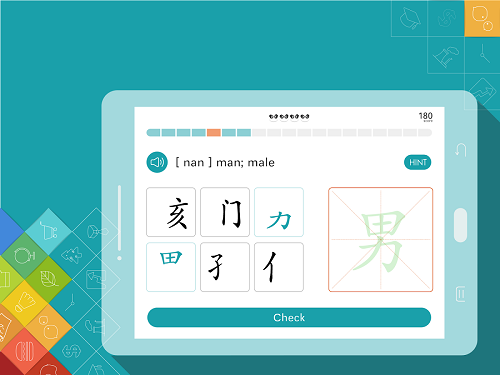Mandarin Chinese is spoken by more people on the planet than any other language so it only makes sense to include Chinese language curriculum in your homeschool lesson planning. A basic education in a second language will help your child strengthen learning skills she can use throughout her life and some studies even suggest that learning a second language develops brain synapses that might not otherwise be used. If a parent/teacher is not familiar with or fluent in Mandarin, he will need assistance in teaching his children, especially with pronunciation; utilizing various approaches and platforms will be the most effective method to help students learn to read, write, and speak Chinese. These top 3 apps for teaching intermediate Chinese will help students take the next step toward Chinese language fluency.
1. Learn Chinese Vocabulary Fast:
Memorize Words will help students who have a basic grasp of Chinese expand their vocabulary through fun activities and memorization tasks. Students can choose to study words from specific categories and will focus on a small amount of words at a time so that they become cemented and natural. Additional words can be added gradually as the child is prepared and is ready to advance. After some practice, students can take the Word Trainer exam and choose English to Chinese or Chinese to English, an option that stretches understanding and ensures the student has truly mastered the meaning of the vocabulary words. Each word is backed up by a native-speaker audio file so children are learning how to speak Chinese, a text option allows students to practice writing Chinese characters, and a time tracking feature helps parent/teachers monitor progress.
2. Learn Chinese (Mandarin) by Brainscape:
Developed with linguistics experts from Columbia and Yale and features flashcards designed to display in specific algorithms based on each user’s confidence level to help students quickly and easily memorize vocabulary. In addition to working on word definitions, an animated stroke order deck helps children practice writing and teaches about Chinese characters and the meaning of each stroke. A list of key phrases will increase a student’s core knowledge of the language and lead to more conversational speech. Feedback, statistics and other tools help students and parent/teachers track progress and a search function allows children to find the words they are struggling to learn for additional practice.
3. Chinese by Living Languages offers 3 levels of lessons:
Esssential, Intermediate, and Advanced. Beginning users can start with vocabulary flashcards and the easiest game levels, but intermediate Chinese speakers can proceed directly to the comprehensive grammar notes, dialogue with native speakers, and harder game levels. Combined, the lessons offer a complete course in the Chinese language, teaching users to speak Chinese using common words and phrases. The games make learning easy and fun while the flashcards assist in memorization. The grammar notes help students learn how to construct both written and spoken sentences while the native speaking dialogue options demonstrate proper pronunciation.
China boasts over a billion citizens so American students who hope to succeed in a global market or contribute to a global society would do well to learn to read, write, and speak at least one Chinese dialect. These apps, alongside other educational opportunities, can help them along the way.
Mimi Rothschild is a veteran homeschooling mother of 8, writer of a series of books called Cyberspace for Kids, and passionate advocate for children and education that is truly worthy of them. In 2001, Mimi and her late husband founded Learning By Grace, a leading provider of online Christian homeschooling Academies.
